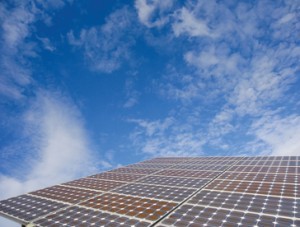By Sarah Glenn/For the Journal
Solar panels
This year in Southeast Idaho the sun is shining, the wind is blowing and the water is rushing — creating a boom in renewable electricity generation. As the grid overflows with power, homeowners are also tossing open the shutters and letting spring breezes do the work of their thermostats.
Supply is up, demand is down and yet, Idaho Power is raising residential rates. The average residential customer can expect to pay about 59 cents more per month beginning June 1. There are other price increase proposals in the works, so you may see more of an increase on your bill come June. Rates went up the year before too by about 3.5 percent.
“It is a little counterintuitive,” said Idaho Power spokesman Brad Bowlin as he tried to
explain the conundrum.
According to Bowlin, a glut of new renewable energy projects pumping electricity into Idaho Power’s grid have thrown a wild card into the price planning equation.
Here comes the sun … and wind and water
As January dawned, 13 solar farms began adding 270 megawatts to Southeast Idaho’s energy grid. Just a year before, that number had been zero. Another 20 megawatts are under contract. Existing wind farms add another 627 megawatts of energy to Idaho Power’s grid.
And then there’s the water.
More than 80 percent of Idaho’s net electricity generation comes from hydroelectric power plants. Four of Idaho’s 10 largest generating facilities run on hydropower. The three dams making up Idaho Power’s Hells Canyon complex on the Snake River constitute the nation’s largest privately owned hydroelectric generating facility, according to the U.S. Energy Information Administration.
Zooming in on Southeast Idaho, hydroelectric usually accounts for 50 percent of net electricity generation. During a long, cool and wet spring that percentage can be as high as 63 percent, Bowlin said.
 “It’s also important to understand that the availability of water for hydroelectric generation depends on many factors, including how fast spring runoff occurs, which in turn shapes how much runoff remains in the summer when demand for electricity peaks,” said Idaho Power Vice President of Regulatory Affairs Tim Tatum. “If the snow melts too quickly, flood control efforts take priority, and in some cases excess water must be spilled, rather than used for generation, to avoid overfilling reservoirs. Idaho Power is currently facing this situation.”
“It’s also important to understand that the availability of water for hydroelectric generation depends on many factors, including how fast spring runoff occurs, which in turn shapes how much runoff remains in the summer when demand for electricity peaks,” said Idaho Power Vice President of Regulatory Affairs Tim Tatum. “If the snow melts too quickly, flood control efforts take priority, and in some cases excess water must be spilled, rather than used for generation, to avoid overfilling reservoirs. Idaho Power is currently facing this situation.”
That’s not to mention the eight other coal fired or natural gas plants scattered across the state. They are also producing a lot of power.
Because of this oversupply, the market price for a megawatt is plummeting. Unfortunately, that puts Idaho Power in a sticky situation.
The PURPA problem
 The nation’s solar and wind farms operate under the federal Public Utility Regulatory Policies Act (PURPA). The act requires Idaho Power to pay for all of the electricity the renewable energy farms generate, even though Idaho Power says it doesn’t need the energy to serve customers’ demands.
The nation’s solar and wind farms operate under the federal Public Utility Regulatory Policies Act (PURPA). The act requires Idaho Power to pay for all of the electricity the renewable energy farms generate, even though Idaho Power says it doesn’t need the energy to serve customers’ demands.
Sometimes the weather cooperates and Idaho’s clean power producers pump out a lot of energy. However, there are the days when the wind doesn’t blow and the sun doesn’t shine.
To make sure the lights stay on across Idaho, utilities need to keep around the more traditional sources (like coal and natural gas).
When faced with excess energy, Idaho Power is forced to reduce output from its own facilities to accommodate the energy from renewable projects. According to a statement from Idaho Power, scaling down its own generation resources, including hydroelectric projects, can still leave the company with excess electricity that must then be sold into a market where prices are low because of a regional oversupply. The company is then forced to pay for high-cost energy when less-expensive resources are available and sell the excess at a loss. The cost of this energy is ultimately passed on to Idaho Power customers through the state-regulated rate-setting process.
Your power bill
With spring runoff flowing down Idaho’s mountains, odds are increasing that the region will see an oversupply of wind, solar and hydro generation when demand for electricity is generally low. It’s a region-wide issue that is already familiar to Idaho Power’s system managers, who have been handling a growing supply of renewable energy for several years. All of their predictions and number crunching culminated in an annual document called the Power Cost Adjustment. Idaho Power files one of these PCA’s every spring with the Idaho Public Utilities Commission.
The PCA is a cost recovery tool that passes on both the benefits and costs of supplying energy to Idaho Power customers. Neither Idaho Power nor its shareholders receive any financial return on this filing — money collected from the surcharge can be used only to pay power-supply expenses. These typically represent approximately one-fourth to one-third of the company’s annual cost of serving customers.
If the PCA proposal is approved by the Idaho Public Utilities Commission, the typical Idaho residential customer using 1,000 kilowatt-hours (kWh) of energy per month will see an increase of about 59 cents on their monthly bill, beginning June 1.
The amount all Idaho customer classes pay for electric service will increase by $10.6 million; the actual percentage of change will depend on a customer’s class and the rate they pay.
The PCA brings last year’s forecast costs in balance with actual expenses by looking back at what happened the previous April through March (called a “true-up”), and forward to the coming April through March (the “forecast”). Rates are established based on the forecast and the true-up to try and make that portion of a customer’s rates equal what it actually costs to provide electricity.
It’s not just Idaho
Once final data are in, the U.S. Energy Information Administration expects that 24 gigawatts (GW) of new generating capacity to be added to the nation’s power grid during 2016. For the third consecutive year, more than half of these additions are renewable technologies, especially wind and solar.
Of the 2016 renewable nationwide additions, nearly 60 percent were scheduled to come online during the fourth quarter. Renewable capacity additions are often highest in the final months of the year, in part, because of timing qualifications for federal, state, or local tax incentives. Estimated fourth-quarter capacity additions for 2016 are based on planned additions reported to EIA and are subject to change based on actual project schedules.
Monthly U.S. renewable electricity generation peaked in March as high precipitation and  melting snowpack led to a monthly peak in hydroelectric generation and strong wind resources led to a monthly peak in wind generation.
melting snowpack led to a monthly peak in hydroelectric generation and strong wind resources led to a monthly peak in wind generation.
Most renewable generation comes from the Western part of the country, which accounted for the majority of the hydroelectric (63 percent) and solar (77 percent) generation in the United States in 2016. Wind generation was more evenly spread across the country with 37 percent occurring in the Midwest, 35 percent in the South, 24 percent in the West, and the remaining 4 percent in the Northeast.
A grim future for new Idaho solar projects
As a solar developer in 2014, the field seemed rich and ready to harvest. These PURPA contracts meant that solar farms would get a fixed, guaranteed price for their power paid for 20 years.
But no more.
In 2015, the Idaho Public Utilities Commission granted a request made by the state’s major utilities to reduce the length of negotiated renewable energy contracts covered by PURPA. The decision reduces the length of contracts to two years, after regulators found longer contracts led to customers paying higher costs for renewable power.
The change means that utilities might be able to better control wild swings in your power bill. But it also means Idaho likely won’t get many more solar farms knocking on its door.
A solar project slated for the Pocatello Regional Airport pulled out in May 2016. If it had gone forward, Pocatello would have pocketed $1,500 per year for the first two years while the solar panels were being built. For 20 years after that, the city of Pocatello would be paid 3.4 percent of the operation’s gross revenues. That’s not to mention the construction jobs. Because of the new length of the PURPA contracts, it’s not coming back.
“This is a big loss for us,” said David Allen, manager of the Pocatello Regional Airport when the solar project canceled. “Nobody can make money in two years.”





